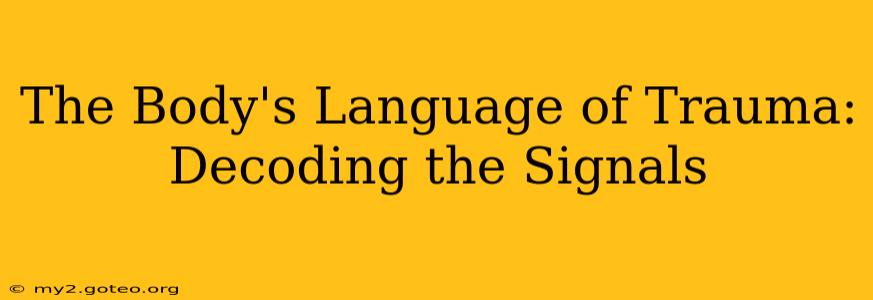Trauma, whether stemming from a single event or prolonged exposure to adversity, profoundly impacts the mind and body. While the psychological effects are often readily discussed, the physical manifestations of trauma are frequently overlooked. Understanding the body's language of trauma is crucial for both those who have experienced trauma and those who support them. This article will explore the various ways the body can communicate the silent story of trauma, answering common questions and offering insights into recognizing and addressing these signals.
What are the physical symptoms of trauma?
The physical symptoms of trauma are incredibly diverse and can manifest in a multitude of ways. These symptoms aren't always immediately linked to a traumatic event; they can emerge subtly over time or be triggered by seemingly unrelated situations. Common physical manifestations include persistent pain (headaches, back pain, stomach aches), sleep disturbances (insomnia, nightmares), digestive issues (irritable bowel syndrome, acid reflux), muscle tension and chronic pain, fatigue and low energy, and changes in appetite (increased or decreased). Furthermore, some individuals experience increased heart rate, difficulty breathing, dizziness, or unexplained tremors. The key is to recognize that these aren't simply "stress symptoms," but potential indicators of deeper, unresolved trauma.
How does trauma affect the nervous system?
Trauma profoundly impacts the nervous system, leading to dysregulation of the autonomic nervous system (ANS). The ANS controls involuntary bodily functions like heart rate, breathing, and digestion. In response to trauma, the ANS can become hyper-activated, leading to a persistent state of "fight, flight, or freeze." This can manifest as chronic anxiety, hypervigilance (increased alertness and fear), and difficulty relaxing. Conversely, some individuals experience hypoactivation, characterized by emotional numbness, dissociation, and a feeling of being disconnected from their body. This chronic dysregulation can significantly impact overall health and well-being.
Can trauma cause chronic pain?
Yes, trauma can be a significant contributor to chronic pain. The body's stress response, triggered by trauma, can lead to prolonged muscle tension, inflammation, and heightened pain sensitivity. This can manifest as chronic pain in various parts of the body, often without a clear physical cause. The connection between trauma and chronic pain is increasingly recognized, and effective treatments often involve addressing both the physical pain and the underlying trauma. It's crucial to consult healthcare professionals who understand the mind-body connection to receive appropriate diagnosis and treatment.
How does trauma manifest in women differently than in men?
While the core effects of trauma can be similar across genders, there are important nuances in how it manifests. Societal expectations and gender roles can influence the expression of trauma symptoms. Women may experience a higher prevalence of certain symptoms, such as somatic complaints (physical symptoms without a clear medical explanation), depression, and anxiety. Men, on the other hand, may be more likely to externalize their trauma through anger, aggression, or substance abuse. These differences highlight the importance of trauma-informed care that recognizes and addresses gender-specific factors.
What are some effective treatments for trauma-related physical symptoms?
Addressing trauma-related physical symptoms requires a holistic approach that often involves a multidisciplinary team. This can include therapy (such as EMDR or trauma-focused CBT), medication (to manage symptoms like anxiety or depression), and somatic therapies (that address the body's experience of trauma). Furthermore, practices such as yoga, mindfulness meditation, and body-based therapies (such as massage or somatic experiencing) can help regulate the nervous system and reduce physical symptoms. The key is to find a treatment plan that addresses both the psychological and physical manifestations of trauma.
How can I tell if my physical symptoms are related to trauma?
Determining whether your physical symptoms are related to trauma requires a careful assessment by a healthcare professional. It’s important to discuss your history, symptoms, and experiences with a therapist or doctor who is familiar with the effects of trauma. They can conduct a thorough evaluation and help determine the underlying cause of your symptoms. Keeping a detailed record of your symptoms, triggers, and any related emotional experiences can be helpful in this process.
This article provides a general overview of the body's language of trauma. It is crucial to seek professional help if you suspect you are experiencing trauma-related symptoms. A skilled healthcare professional can provide a proper diagnosis and develop an individualized treatment plan to address your unique needs. Remember, healing from trauma is possible, and understanding the body’s response is a critical first step on the road to recovery.

